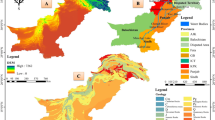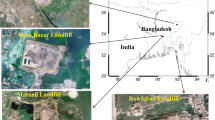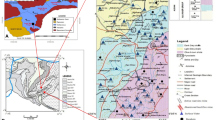Abstract
Arsenic (As), a toxic trace element, is of great environmental concern due to its presence in soil, water, plant, animal and human continuum. Its high toxicity and increased appearance in the biosphere have triggered public concern. The present study measured As concentrations in soil, groundwater and rice plant samples of five selected blocks of Maldah district, West Bengal, India. Soil, irrigation water and rice plant samples were collected from the fields of the selected study areas. The results revealed the presence of As in higher concentrations than the maximum permissible limit of As in irrigation water (0.1 mg L−1 by FAO, 2010) in groundwater of Manikchak (0.553 ± 0.17 mg L−1), Kaliachak III (0.528 ± 0.20 mg L−1), and Kaliachak II (0.449 ± 0.15 mg L−1), Kaliachak I (0.207 ± 0.19 mg L−1). The soil As was also found higher in those four blocks. The As content in rice grain of the study area was positively correlated (r = 0.896**, p < 0.001) with As content in irrigation water. The data of consumption of rice per day in the survey were used for the measurement of average daily intake, Hazard quotient (HQ) and Incremental Life time Cancer Risk. Kaliachak III, Manikchak and Kaliachak II showed HQ greater than 1, indicating the possibility of non-carcinogenic health hazard due to As exposure to the local residents. The study emphasized the severity of As problem in remote areas of West Bengal where people consume As tainted rice due to lack of awareness about the As associated health issues.
Graphic Abstract






Similar content being viewed by others
References
Abedin MJ, Feldmann J, Meharg AA (2002) Uptake Kinetics of Arsenic Species in Rice Plants. Plant Physiol 128:1120–1128. https://doi.org/10.1104/PP.010733
Arumugam G, Rajendran R, Ganesan A, Sethu R (2018) Bioaccumulation and translocation of heavy metals in mangrove rhizosphere sediments to tissues of Avicenia marina – A field study from tropical mangrove forest. Environ Nanotechnol Monit Manag 10:272–279. https://doi.org/10.1016/j.enmm.2018.07.005
Biswas JK, Warke M, Datta R, Sarkar D (2020) Is Arsenic in Rice a Major Human Health Concern? Curr Pollut Reports 6:37–42. https://doi.org/10.1007/S40726-020-00148-2
Census, 2011 Maldah district: Census 2011 data, Government of India. http://www.census2011.co.in/census/district/10-maldah.html
Chowdhury NR, Das A, Joardar M, De A, Mridha D, Das R, Rahman MM, Roychowdhury T (2020) Flow of arsenic between rice grain and water: Its interaction, accumulation and distribution in different fractions of cooked rice. Sci Total Environ 731:138937. https://doi.org/10.1016/j.scitotenv.2020.138937
FAO, 2014 Maximum Levels for Inorganic Arsenic in Polished Rice. Codex Alimentarius Commission, Geneva, Food and Agricultural Organization of the United Nations. Accessed 3 December (2018). http://www.fao.org/news/story/en/item/238558
FAO, UNICEF, WHO, WSP (2010) Towards an Arsenic Safe Environment in Bangladesh. 1–20.
FSSAI, 2011 Food safety and standards (food products standards and food additives) regulations, 2011. F.No. 2–15015/30/2010. New Delhi: Food Safety and Standards Authority of India. Ministry of Health and Family Welfare.
Golui D, Mazumder DNG, Sanyal SK, Datta SP, Ray P, Patra PK, Bhattacharya K (2017) Safe limit of arsenic in soil in relation to dietary exposure of arsenicosis patients from Malda district, West Bengal- A case study. Ecotoxicol Environ Saf 144:227–235
Guha Mazumder D, Dasgupta UB (2010) Chronic arsenic toxicity: Studies in West Bengal, India. Kaohsiung J Med Sci 27:360–370. https://doi.org/10.1016/j.kjms.2011.05.003
Halder D, Biswas A, Šlejkovec Z, Chatterjee D, Nriagu J, Jacks G, Bhattacharya P (2014) Arsenic species in raw and cooked rice: implications for human health in rural Bengal. Sci Total Environ 98:200–208. https://doi.org/10.1016/j.scitotenv.2014.07.075
Hussain MM, Bibi I, Niazi NK, Shahid M, Iqbal J, Shakoor MB, Ahmad A, Shah NS, Bhattacharya P, Mao K, Bundschuh J, Ok YS, Zhang H (2021) Arsenic biogeochemical cycling in paddy soil-rice system: Interaction with various factors, amendments and mineral nutrients. Sci Total Environ 773:145040. https://doi.org/10.1016/j.scitotenv.2021.145040
Jackson ML (1973) Soil Chemical Analysis. Prentice Hall of India Pvt. Ltd., New Delhi, p 498
Khanam, R 2021 Profiling of arsenic in Rice. Bidhan Chandra Krishi Viswavidyalaya, pp 1–200.
Khanam R, Kumar A, Nayak AK, Shahid M, Tripathi R, Vijayakumar S, Bhaduri D, Kumar U, Mohanty S, Panneerselvam P, Chatterjee D, Satapathy BS, Pathak H (2020) Metal(loid)s (As, Hg, Se, Pb and Cd) in paddy soil: Bioavailability and potential risk to human health. Sci Total Environ 699:134330. https://doi.org/10.1016/j.scitotenv.2019.134330
Kumarathilaka P, Seneweera S, Meharg A, Bundschuh J (2018) Arsenic accumulation in rice (Oryza sativa L.) is influenced by environment and genetic factors. Sci Total Environ 642:485–496. https://doi.org/10.1016/j.scitotenv.2018.06.030
Mawia AM, Hui S, Zhou L, Li H, Tabassum J, Lai C, Wang J, Shao G, Wei X, Tang S, Luo J, Hu S, Hu P (2021) Inorganic arsenic toxicity and alleviation strategies in rice. J Hazard Mater 408:124751. https://doi.org/10.1016/j.jhazmat.2020.124751
McCleskey RB, Nordstrom DK, Maest AS (2004) Preservation of water samples for arsenic(III/V) determinations: An evaluation of the literature and new analytical results. Appl Geochem 19:995–1009
Mochizuki H (2019) Arsenic neurotoxicity in humans. Int J Mol Sci 20(14):3418. https://doi.org/10.3390/ijms20143418
Nurchi VM, Djordjevic AB, Crisponi G, Alexander J, Bjørklund G, Aaseth J (2020) Arsenic toxicity: Molecular targets and therapeutic agents. Biomol 10(2):235
Piper CS, (1966) Soil and plant analysis, Hans Pub, Bombay. Asian Ed, pp.368–374.
Purkait B, Mukherjee A (2008) Geostatistical analysis of arsenic concentration in the groundwater of Malda district of West Bengal, India. Front Earth Sci 2:292–301. https://doi.org/10.1007/S11707-008-0023-Z
Rahman MA, Hasegawa H, Rahman MM, Rahman MA, Miah MAM (2007) Accumulation of arsenic in tissues of rice plant (Oryza sativa L) and its distribution in fractions of rice grain. Chemosphere 69(6):942–948
Rahman S, Sinha AC, Pati R, Mukhopadhyay D (2013) Arsenic contamination: a potential hazard to the affected areas of West Bengal, India. Environ Geochem Health 35:119–132. https://doi.org/10.1007/s10653-012-9460-4
Saadat MN, Gupta K (2016) Impact of soil on the productivity of mango crop in Malda district, West Bengal. Am Int J Res Humanit Arts Soc Sci 14:121–126
Samal AC, Kar S, Maity JP, Santra SC (2013) Variety-specific arsenic accumulation in 44 different rice cultivars (O. sativa L.) and human health risks due to co-exposure of arsenic-contaminated rice and drinking water. J Hazard Mater 407:124804
Samal AC, Bhattacharya P, Biswas P, Maity JP, Bundschuh J, Santra SC (2021) Arsenicosis and its relationship with nutritional status in two arsenic affected areas of West Bengal, India. J Asian Earth Sci 77:303–310. https://doi.org/10.1016/j.jseaes.2013.07.009
Sand S, Bjerselius R, Busk L, Eneroth H, Sanner-Färnstrand J, Lindqvist R (2015). The Risk Thermometer - A Tool for Risk Comparison. https://doi.org/10.5281/zenodo.1220134
Schmidt AC, Mattusch J, Reisser W, Wennrich R (2004) Uptake and accumulation behaviour of angiosperms irrigated with solutions of different arsenic species. Chemosphere 56:305–313. https://doi.org/10.1016/j.chemosphere.2004.02.031
Shaji E, Santosh M, Sarath KV, Prakash P, Deepchand V, Divya BV (2020) Arsenic contamination of groundwater: A global synopsis with focus on the Indian Peninsula. Geosci Front 12:101079. https://doi.org/10.1016/j.gsf.2020.08.015
Shrivastava A, Barla A, Singh S, Mandraha S, Bose S (2017) Arsenic contamination in agricultural soils of Bengal deltaic region of West Bengal and its higher assimilation in monsoon rice. J Hazard Mater 324:526–534. https://doi.org/10.1016/j.jhazmat.2016.11.022
Singh J, Upadhyay SK, Pathak RK, Gupta V (2011) Accumulation of heavy metals in soil and paddy crop (Oryza sativa), irrigated with water of Ramgarh Lake, Gorakhpur, UP. India Toxicol Environ Chem 93(3):462–473. https://doi.org/10.1080/02772248.2010.546559
Upadhyay MK, Majumdar A, Barla A, Bose S, Srivastava S (2019) An assessment of arsenic hazard in groundwater–soil–rice system in two villages of Nadia district, West Bengal. India. Environ Geochem Health 41(6):2381–2395
Walkley A, Black IA (1934) An Examination of the Degtjareff Method for Determining Soil Organic Matter, and a Proposed Modification of the Chromic Acid Titration Method. SoilS 37:29–38. https://doi.org/10.1097/00010694-193401000-00003
Acknowledgements
Authors acknowledge the support of All India coordinated Research project (AICRP) on Micro and Secondary nutrients and pollutant elements in soils and plants for providing necessary facilities for execution of this study.
Author information
Authors and Affiliations
Contributions
RK had done the field experiments and the laboratory analyses. GCH conceptualized the study and finalized the methodologies. PGPSK had done statistical analysis of the data. RK and PGPSK prepared the first draft. All authors subsequently added their inputs and improved the MS. GCH had done the overall supervision of the entire research study, manuscript revisions and corrections.
Corresponding author
Ethics declarations
Conflict of interest
The authors declare that they do not have any conflict of interest.
Consent to Participate
All authors informed consent to participate in this paper.
Consent to Publish
All authors informed consent to publish this paper.
Supplementary Information
Below is the link to the electronic supplementary material.
Rights and permissions
About this article
Cite this article
Khanam, R., Hazra, G.C., Ghosh Bag, A. et al. Risk Assessment of Arsenic Toxicity Through Groundwater-Soil-Rice System in Maldah District, Bengal Delta Basin, India. Arch Environ Contam Toxicol 81, 438–448 (2021). https://doi.org/10.1007/s00244-021-00883-7
Received:
Accepted:
Published:
Issue Date:
DOI: https://doi.org/10.1007/s00244-021-00883-7




